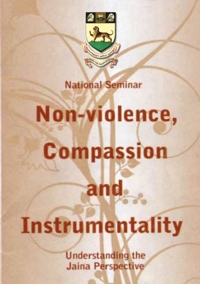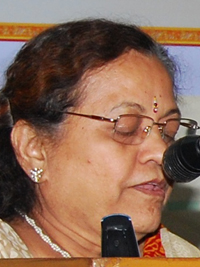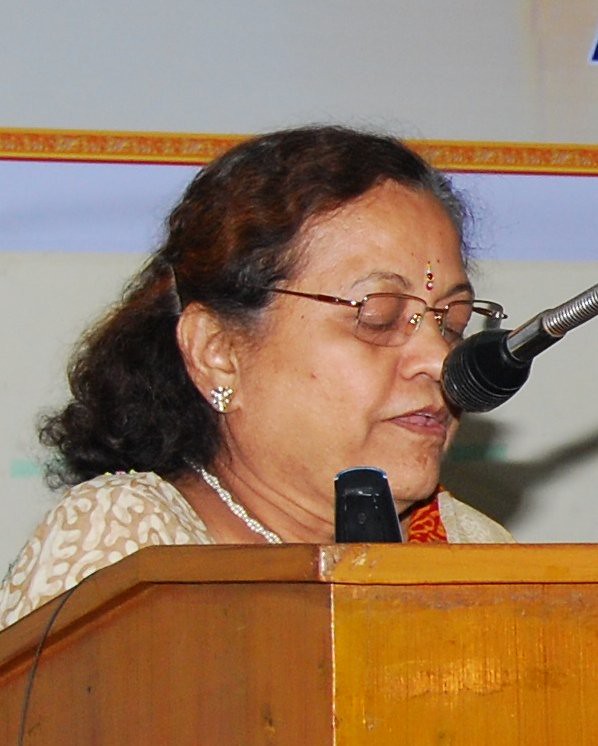Chennai 2009: Non-violence, Compassion and Instrumentality - A Jaina Perspective
 | Non-violence, Compassion and InstrumentalityA Jaina PerspectiveSeminar organized by the Department of Jainology of the University of Madras, 13 and 14 February 2009 Chennai, India |
The Quest for Non-violence – Vision of World Peace
13.02.2009
Introduction
In the present scenario, the entire world is inflicted with revengeful tactics of killing innocent people. The reason is nothing but fury, extreme jealousy, fanaticism, rigidity, predominant ego and lust for power of some misguided groups. Their mission is not solidarity but to spread terror in the world in the name of revenge.
Is there any solution to maintain peace in the world? Can Jainism help in restoring harmony? Yes, Jainism has a solution. Its principals are most relevant in the current situation and by implementing them; conciliation among rival groups is possible.
The present paper highlights the role of Jainism, in bringing out civilized, cultured peace loving societies in the world through its basic notions of nonviolence and compassion. It also throws light on some successful experiments where truth and ahimsa are used to achieve goal and victory over violence.
We know that the phenomenon of violence is not new. What is new is the powerful technology being used and the mastermind behind the conflicting societies.
The Root Cause of Violence and its Solution as per Scriptures
According to text Saman Suttam the presence of attachment and hatred in thought is deliberated as violence while the absence of Raga-Dwesha in the mind is reckoned with Ahimsa/non-violence.
Ragadinamanuppao ahimsakattam iti desiyam samae
Tesim che uppatti, himsetti jinehi nididittha.
- Samana Suttam - Ahimsa Sutram, 7Here the generation of attachment and hatred with passions are taken into account as violence. When it generates in one’s mind, it changes first one’s thoughts, and then the violent thoughts are next converted into action.
The shloka from the Uttaradyayana Sutra explains non-violence as to reflect equanimity to everyone.Samaya sashhahuesu, sattu - mittestu va jage,
Panaivaya virai, javajivanam dakkaram.
- Uttaraddhyayana Sutra, Adhya.-17, Gatha-24)It explains that one must be balanced towards all living beings- whether a friend or an enemy. This is true non-violence in real sense. Such religious sermons of scriptures sow the seeds of compassion into the laymen by which a crop of non-violence could be harvested. It is difficult to control passions but with the help of Jaina tenets one can create Samata bhava in mind. The positive attitude too helps in developing Samata bhava which controls the selfish activity in mind and does not allow any type of ill thoughts into practice
Inspiration of non-violence - by renowned persons
Inspiration can be drawn from the lives of great personalities like Bhagawan Mahavira, Gautama Buddha, Mahatma Gandhi and Mother Teresa to improve self. They have spread the message of non-violence through their behavior and sermons. We know that Gandhiji used the non-violence precepts of Shree Mahavira as a powerful weapon for freedom struggle and he succeeded. Afterwards Gandhi Vichar dhara and Gandhian thought, related to ahimsa and compassion became world famous.
Our Jain acharyas are conducting camps/shibiras for improvement of societies without any cast and creed discrimination. Such efforts are necessary as they are very effective in the present era. To bring peace in the world one has to achieve it from within, for that he has to become more spiritually inclined with the help of spiritual leaders.
Instruments of peace in the present time
In India, many jail authorities conduct meditation camps and discourses of religious personalities to improve prisoners. By such method of improving cruel minded persons, one Hong Kong based prisoner David Ming improved himself by performing yoga, meditation and vipasyana in camps. When he was freed from jail, his old colleagues wanted to drag him again in illegal business but he refused. Later on he joined as a transcriber with the help of Mrs. Kiran Bedi.
According to Kiran Bedi, 96% of all crimes are not registered, therefore to help people and to reduce the crimes she has launched an email address from the current year 2008 - saferindia.com. - The name of her working NGO is INDIA VISION FOUNDATION. Recently she has started a talk show on TV to solve domestic problems. Her priority is prevention of crimes and terrorism. She is getting assistance from retired police officers, civil servants and law students. She has proved that the process of reforming hard core criminals and prisoners, though difficult, could be possible only by nonviolence and anekanta as per her book It Is Always Possible.
The general strategy of improving criminals is to ask them a few questions regarding the reasons behind the crime and its circumstances. Next is to study their behavior with the help of other inmates, to get rid of his bad habits. This powerful lady has succeeded in changing the cruel minds of criminals into peace loving humans by religious ethics. She has achieved this difficult task within the legal framework in Tihar jail, by teaching meditation, prayers, vipasyana and lectures of recluses. She has also shown the technique of improving criminals in society by observance of gross non-violence like equanimity and brotherhood. This process also helps in the removal of many socio-economic problems.
A very good example of change of heart has been reported by the media recently. Laxman Gole, a prisoner with 14 cases of kidnapping, assault etc. against him, read Gandhiji’s autobiography My Experiments with Truth. This wonderful book impressed him. He was inspired to confess all his crimes in the court. The judge was so moved by his confessions that he reduced his punishment within the limit of Indian Penal Code. His sentence is completed and now he is propagating nonviolence among people. According to him hate and violence beget nothing, so in today’s troubled times it is better to walk on the path of non violence. Reading his story in newspaper prompted the Mumbai Sarvodaya Mandala to distribute such books to prisoners.
At Ahmedabad, an NGO based woman’s section AWAG works to build harmony among different communities. The activity of this group is to bring about a positive change in the lives of people of different communities. During the communal riots, AWAG has worked with other government organizations to restore harmony within the individuals and then in the city. Thus to achieve peace we have to change both - the individual and the system of society.
Nonviolence as the most effective solution for peace
ConclusionThe global recognition of non-violence as a solution for peace against terror activities is also accepted by the UNO. The declaration of Mahatma Gandhi’s birthday, 2nd October as Ahimsa day, is a sign of this acceptance. Now it is our moral duty to spread the tenet of Ahimsa of Jaina faith as an important ethic. We have to promote it to eliminate corruption, economic exploitation and eco-balance too. We can conduct workshops and training camps for Ahimsa as a life ethic as we have the role model of Mahatma. His movement of Satyagraha and Non-cooperation are the two tried and tested methods taught by him to solve various problems.
The peace emitting vibrations of great personalities can spread the message of brotherhood and equanimity in the world till centuries. Thus peace can be restored by universal love and brotherhood as love binds men all over world, irrespective of language, religion or caste.
To develop good habits in children tremendous care must be taken by parents to teach them ethics through the stories of great seers. Sometimes news channels and cable operators, instead of showing value based cultured films only give coverage to sensational news. Here showing value based cultured films like Gandhi and Munnabhai can also change the thinking of the public. Sometimes young men are misguided in the name of religion. They could be guided by producing compassion, sympathy and spiritual moral thoughts. Terrorist organizations select youngsters for the purpose of suicide bombings. They are first brainwashed with dirty politics, then they are either used as human bombs or as terrorists to spread terror in the world. To avoid such happenings internet and other Media could be used to provide correct advice and teaching them correct religious morals. If every person in the world controls their own mind i.e. without being ‘brainwashed’ by other misguided men then there will not be any conflict in societies. The antidote of terrorism requires the use of modem technology and equipment to spread message of non-violence and anekanta.
Today the whole world is facing the global menace of inequality, poverty, ecological imbalance and terrorism. Men have prepared nuclear bombs which can destroy anything within seconds by just pressing buttons. All nations must sign a treaty on the ban of weapons, in the interest of humanity. The need for implementation of Jaina doctrine of non-violence is most urgent as it invokes peace very effectively.
None of the religions of the world has ever taught men to hate, to exploit or to fight with others. On the contrary it urges to live with peace and friendship.
The root cause of conflict is the lack of mutual relation between different civilization and religious groups. The solution of such problems lies in spreading true knowledge of spiritualism to the young generation, to dispel the darkness of ignorance. For the construction of peace and solidarity in human mind it is indispensable to comprehend human nature. Man is very greedy animal. There is no end to his desires. One has to possess belongings as per one’s need as craving develops ill thought in minds, resulting conflict with others. The program of teaching anuvrata, anekanta, meditation, yoga and spirituality must be carried out to awaken destructive people.
By opening intra social and intra cultural talk with various forums, respecting each others points of view will help in bringing peace to world. The essence of all religions is brotherhood and equanimity to all.
Thus to control multifaceted violence, fully equipped with advanced technology is not as easy as it seems, but peace can be established by mutual understanding and through dialogues with concerned groups. Awareness of nonviolence and development of ethical values go together in one stream as basic tenets of all religion are the same. The vision of world peace can be realized by awakening the spiritual consciousness, nonviolence and compassion among people.
Reference Books:
Samana Suttam compiled by Shri Jinendra Varni, published by Bhagwan Mahavira Kendra, New Delhi. It is Always Possible by Mrs. Kiran Bedi. Divya Bharti Gujarati dated 7th Jan 2008. Hindustan Times dated 8th Jan 2008 Certificate Journal Jainology for Agama slokes
 Dr. Renuka J. Porwal
Dr. Renuka J. Porwal
